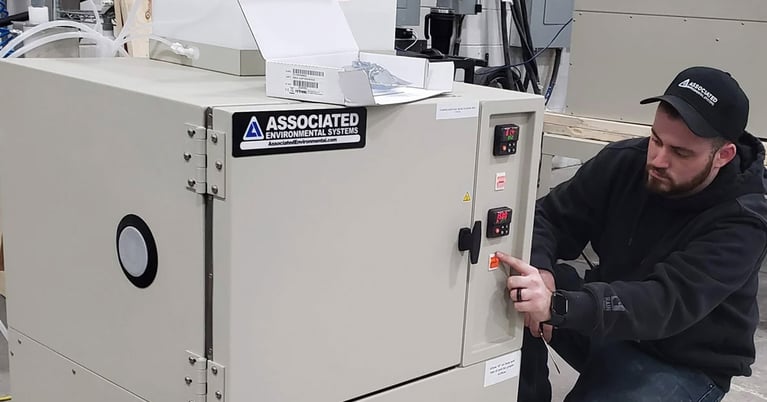Maintenance Tips for Environmental Test Chambers

Maintenance is essential. Like any house or car, routine environmental testing maintenance should always be top-of-mind. Test chambers can begin showing signs of imminent repair, from water leaks and rust to corrosion, pooling, and condensation. These types of issues can stem to more significant problems later if overlooked.
Get ahead of issues before they become expensive fixes. At Associated Environmental Systems (AES), we encourage our customers to practice regular and annual test chamber maintenance, check chamber performance before testing, and keep test chamber manuals close by. For issues that arise, lean on our common test chamber maintenance checks. These tips will help you understand the problem and create an effective solution.
Test Chamber Maintenance Checks
While you can conduct various maintenance checks independently, looping in your internal service team is important. Someone skilled in HVAC and refrigeration is handy! Above all, when completing environmental test chamber service, safety is paramount. Test chambers are connected to live voltage. A professional should perform any maintenance work on the electrical system. Ensure the chamber is disconnected from power following the appropriate lockout-tagout process before doing any maintenance.
Electrical System
When inspecting your electrical systems, you’ll want to look for pitting and loose connections on relays, contacts, wire harnesses, solenoids, sensor clips, and compressor connections. Check that ground wires and phasing are correct and examine electrical readings at all connections and terminations using a multimeter. Take the necessary amperage readings and look at the high and control voltage. Before completion, test all the control switches and lights to see if they’re operational.
Refrigeration System
Every refrigeration system check should include an inspection of the oil level, along with leaks and build-up. Check the various fan operations, cap tubes, pipe supports, and pipe insulation. There should be no frost build-up anywhere, the air handler should be tight without leakage, and be sure to examine the vibration eliminators. Upon inspection, you should always check the static and operating pressures and discharge, and suction and liquid line temperatures. Since PSI information is specific to your chamber, measure the correct filter drier psi for restrictions, and don’t forget to clean the coils and straighten bent fins.
Humidity System
If you have a humidity chamber, inspect the float, water tubing and connections, and optional air drier. Drain, clean, and flush the water lines, steam generator, and optional reservoir. Inspect the steam generator heater for pitting and verify water quality and pressure. Lastly, be sure to examine the dry air purge operation and filters.
Circulation System
To complete a circulation system check, inspect the pump and connecting lines looking for water leaks. The drain tank should only have a small amount to clear sediment. Clean the pump and thoroughly clean the tank. You’ll also want to inspect the overall structure of the test chamber: the exterior, workspace, and floor panels for punctures, tears, and dents. Check the degradation of all gaskets: door(s), window(s), port(s), wiring, and plug(s).
If you have a walk-in environmental chamber with panels, check the seal at each seam. Inspect the integrity of panel locks or latches. Verify that the door operation creates a smooth seal by inspecting the latch, catch, and hinges. Clean the drain and condensate pump and adjust the airflow registers. Remove all dust and debris by vacuuming or blowing out the electrical and mechanical machine areas. If needed, replace any missing or damaged safety tags and labels. After finishing, return the test chamber to the correct location, allowing an 18- to 36-inch space for optimal airflow for best chamber performance.
Salt Spray Chambers
If you have a salt spray chamber, you'll want to ensure the tower and the siphon tube assembly are clean. If not cleaned or cleaned properly, salt can build up and impede the function of the chamber. Be sure to clean with warm water and blow dry with air.
The Importance of Calibration
Inspecting the overall structure and system of your test chamber is imperative. Apart from checking the exterior, workspace, and floor panels, gaskets, and seals, don’t forget to check your chamber controllers routinely. Since regular calibration prevents “drift,” resulting in inaccurate testing outcomes, we highly recommend having an expert calibrate your chambers’ controllers around every six months to a year, depending on chamber usage. Well-maintained test chambers often outlast the controllers that keep them operating, so if you have an older controller, consider upgrading to a new one to keep it running longer. You’ll also gain access to software such as AESONE when retrofitting with AES.
Rely on AES for Your Service Needs
Identifying problems and solving them before they escalate is always the safer route. Staying vigilant will save you time and money and maintain the longevity of your chamber. Committed to exceptional service, AES is readily available to help diagnose and troubleshoot your issues. Our nationwide factory technicians can travel for onsite test chamber repairs, getting you the needed support. Reach out to us at 1-978-707-6648 to learn more.



